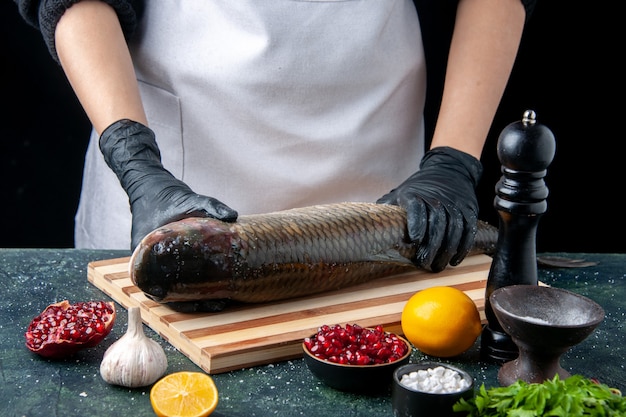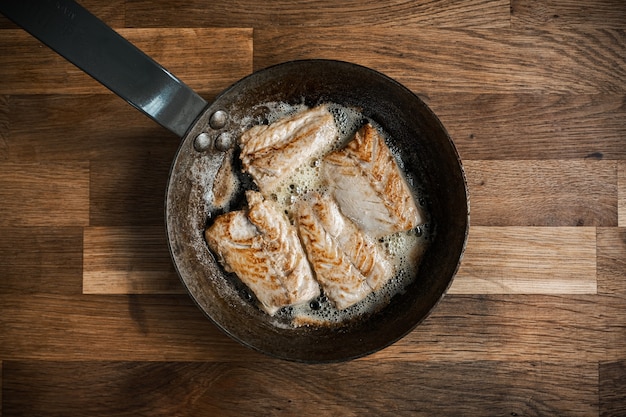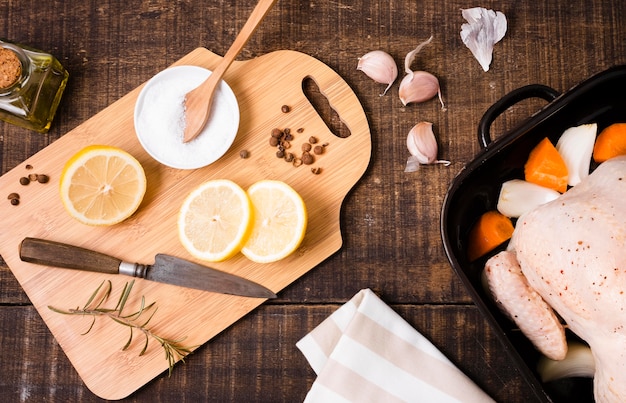Let's face it, cod gets a bit of a bad rap sometimes. It's often seen as the "basic" fish, the default choice for fish and chips. But trust me, cod is a culinary gem waiting to be discovered! This mild-mannered fish is surprisingly versatile, capable of transforming into a symphony of delicious dishes. Whether you're a seasoned cook or just starting out, cod is a great choice because it's easy to work with and truly forgiving. So, grab your aprons and let's embark on a culinary adventure together.
Part 1: Cod 101: Getting to Know Your Fish

Before we dive into the delicious recipes, let's get acquainted with our star ingredient. Cod, a member of the Gadidae family, is a white, flaky fish with a mild, almost sweet flavour. This is what makes it such a blank canvas for culinary creativity. Cod absorbs flavours beautifully, making it perfect for a wide range of seasonings and sauces.
Choosing the Right Cod: Fresh vs. Frozen
Now, the first decision you'll need to make is whether you prefer fresh or frozen cod. Fresh cod, if you can find it, offers the most intense flavour. It should have firm, bright white flesh, and a clean, fresh smell. Avoid any fish that smells "fishy" or has a dull appearance.
Frozen cod is a great alternative, especially if fresh isn't readily available. Look for packages that are frozen solid with no signs of ice crystals. Just remember to defrost it properly before cooking.
Cod Cuts: Knowing Your Options
Next, let's talk about the cuts. Cod comes in a variety of forms, each with its own benefits:
- Fillets: These are the most common cuts, sliced from the sides of the fish. They're perfect for individual portions and are usually boneless, making them super convenient.
- Steaks: These are thicker, cross-section cuts, often with the skin still on. They're great for grilling or pan-frying because they hold their shape well.
- Whole Cod: This is the entire fish, usually gutted and scaled. It's ideal for roasting or baking and creates a truly impressive centrepiece for a special occasion.
Storage and Handling: Keeping Your Cod Fresh
Now, how do we keep this precious fish in top condition? Fresh cod is best used within a day or two, stored in the fridge wrapped in a damp paper towel. This helps to prevent it from drying out. Frozen cod, on the other hand, can last for months in the freezer.
When handling cod, remember it's delicate. Avoid excessive washing, as it can lead to the flesh becoming waterlogged. A quick rinse under cold water is usually enough.
Part 2: Preparing Cod for Cooking: A Quick Guide

Alright, now we're getting to the good stuff! Before we can whip up those delectable cod dishes, we need to prepare the fish. It's a simple process, but it makes a world of difference in the final taste and texture.
Removing Skin and Bones
If you're using fillets with skin, you might want to remove it. Use a sharp knife to gently slide under the skin, then carefully peel it away. It's not essential, but it does create a more refined presentation.
Cod is generally quite boneless, but you might find a few pin bones. Use a pair of tweezers to pluck them out – a quick and easy step to avoid any unpleasant surprises.
Seasoning Your Cod: Unleashing Flavour
Now comes the fun part: seasoning! Cod's mild flavour makes it a blank canvas for all sorts of spices and herbs. Salt and pepper are always a good starting point, but don't be afraid to get creative. Consider adding a touch of garlic powder, paprika, thyme, a pinch of chilli flakes, or even a sprinkle of citrus zest.
To really elevate your seasoning game, consider using a dry brine. Simply rub the cod fillets with salt and pepper, then leave them in the fridge for 30 minutes to an hour. This will help to draw out the moisture and allow the flavours to penetrate the fish more deeply.
Part 3: Cooking Cod: Your Essential Techniques

We've chosen our cod, prepared it, and seasoned it. Now it's time to get cooking! And let me tell you, there are plenty of delicious ways to do it.
Pan-Frying: Quick and Easy
This method is perfect for weeknights when you're short on time. Simply heat a little oil in a pan over medium heat, add the cod, and cook for 3-4 minutes per side. You want the fish to be opaque and flaky, and just slightly golden brown.
Baking: Hands-Off Perfection
Baking offers a more hands-off approach. Preheat your oven to 350°F (175°C), place the cod on a baking sheet, and bake for 15-20 minutes, or until cooked through. You can also add vegetables or herbs to the baking sheet for a more flavourful meal.
Grilling: A Touch of Smoke
For a smoky flavour, grilling is the way to go. Heat your grill to medium-high heat, place the cod on the grill, and cook for 4-5 minutes per side. Make sure you don't overcook it, or it will become dry.
Poaching: Gentle and Delicious
Poaching is a gentle cooking method that helps to retain the cod's delicate flavour. Bring a pot of water or broth to a simmer, add the cod, and cook for 5-7 minutes. This is a great option if you want to keep the fish moist and tender.
Part 4: cod recipes: A Feast for the Senses
Now for the recipes! These are some of my personal favourites, designed to showcase the versatility of this wonderful fish.
Classic pan-fried cod with Lemon and Herbs
This is a timeless classic, and for good reason! It's simple, delicious, and perfect for any occasion. The fresh lemon and herbs brighten up the cod's natural flavour, creating a dish that's both elegant and satisfying.
Ingredients:
- 4 cod fillets
- 2 tablespoons olive oil
- 1 lemon, thinly sliced
- 2 tablespoons chopped fresh parsley
- 1 tablespoon chopped fresh dill
- Salt and pepper to taste
Instructions:
- Season the cod fillets with salt and pepper.
- Heat the olive oil in a large skillet over medium heat.
- Add the cod fillets to the pan and cook for 3-4 minutes per side, or until opaque and flaky.
- Top each fillet with a slice of lemon and a sprinkle of parsley and dill.
- Serve immediately.
Honey Garlic Glazed Cod
Looking for something a little more adventurous? This recipe packs a punch with a sweet and tangy glaze. The honey and garlic create a beautiful balance of flavours, while the glaze adds a touch of shine and richness.
Ingredients:
- 4 cod fillets
- 2 tablespoons olive oil
- 2 tablespoons honey
- 2 tablespoons soy sauce
- 1 tablespoon rice vinegar
- 1 clove garlic, minced
- 1 teaspoon grated ginger
- 1/2 teaspoon sesame oil
- Salt and pepper to taste
Instructions:
- In a small bowl, whisk together the honey, soy sauce, rice vinegar, garlic, ginger, sesame oil, salt, and pepper.
- Heat the olive oil in a large skillet over medium heat.
- Add the cod fillets to the pan and cook for 3-4 minutes per side, or until opaque and flaky.
- Pour the honey garlic glaze over the cod and cook for 1-2 minutes, or until the glaze is thickened and bubbly.
- Serve immediately.
baked cod with Tomato and Basil
This recipe is a flavour bomb, combining the sweetness of tomatoes with the freshness of basil. It's a simple yet elegant dish that showcases the cod's natural flavour beautifully.
Ingredients:
- 4 cod fillets
- 1 tablespoon olive oil
- 1 onion, chopped
- 2 cloves garlic, minced
- 1 (28-ounce) can diced tomatoes, undrained
- 1/2 cup chopped fresh basil
- Salt and pepper to taste
Instructions:
- Preheat oven to 375°F (190°C).
- Heat the olive oil in a large skillet over medium heat.
- Add the onion and garlic and cook until softened, about 5 minutes.
- Stir in the diced tomatoes and basil.
- Season with salt and pepper.
- Pour the tomato mixture into a baking dish.
- Place the cod fillets on top of the tomato mixture.
- Bake for 15-20 minutes, or until the cod is cooked through.
- Serve immediately.
Part 5: Accompanying Cod: Sides for a Perfect Meal
Now that we have some amazing cod recipes in our arsenal, let's talk about the perfect accompaniments.
Starchy Sides: Pairing with Cod
Cod loves starchy sides! They provide a comforting contrast to the flaky fish. Think creamy mashed potatoes, fluffy rice pilaf, or a simple salad of roasted potatoes seasoned with herbs and garlic.
Green Delights: Balancing the Plate
To add a touch of freshness and colour, you can't go wrong with a vibrant green side. Asparagus, broccoli, or a simple green salad with a light vinaigrette would all work beautifully.
Savoury Complements: Elevating the Flavour
And finally, for a truly satisfying meal, consider adding a savoury side to your cod. A simple side of sautéed mushrooms, roasted peppers, or even a small serving of pasta would make a lovely addition.
Part 6: Cod: Beyond the Plate: A Sustainable Choice
Now, you've got your recipes, your sides, and you're ready to cook up a storm. But let's pause for a moment and talk about something really important: sustainability.
Cod, like many fish species, has faced overfishing in the past. This is why choosing sustainably caught cod is crucial.
Look for Certification
When shopping for cod, look for certifications like the Marine Stewardship Council (MSC). This label indicates that the fish comes from a well-managed fishery that is sustainable and environmentally responsible.
Ask Your Fishmonger
If you're unsure about the source of your cod, don't hesitate to ask your fishmonger. They can usually tell you where the fish was caught and whether it was caught sustainably.
Choose Alternative Species
And remember, there are other delicious fish options out there! If cod isn't readily available, consider exploring other sustainable choices, like pollock, hake, or basa.
Part 7: Cod Cuisine Around the World: A culinary journey
Did you know that cod is a culinary staple in many different cultures around the world? From the fish and chips of Britain to the bacalhau of Portugal, cod has been enjoyed for centuries.
Fish and Chips: A British Classic
This iconic dish needs no introduction. Crispy, golden-fried cod dipped in thick, creamy batter, served with a generous portion of chips – pure comfort food heaven!
Bacalhau: A Portuguese Treasure
This is a traditional Portuguese dish that features dried and salted cod, rehydrated and cooked in a variety of ways. From bacalhau à Gomes de Sá (with potatoes and olives) to bacalhau com broa (with bread crumbs), there's a bacalhau recipe for every taste.
cod liver oil: A nutritional powerhouse
Now, this one might not be everyone's cup of tea, but cod liver oil is a nutritional powerhouse. Rich in vitamin A and D, it's been a popular supplement for centuries.
Part 8: FAQs: Your Cod Cooking Questions Answered
Got some questions about cooking cod? Don't worry, we've got you covered.
1. How do I know when cod is cooked?
The best way to tell if cod is cooked through is to check for flakiness. The flesh should be opaque and flake easily with a fork.
2. What happens if I overcook cod?
Overcooked cod can become dry and rubbery. It's best to err on the side of undercooking, as it can always be cooked a little longer if necessary.
3. Can I freeze cooked cod?
Yes, you can freeze cooked cod. Simply cool it completely, then store it in an airtight container or freezer bag for up to 3 months.
4. What are the best ways to serve cod?
Cod is incredibly versatile! You can serve it with simple sides like mashed potatoes and vegetables, or you can create more elaborate dishes with sauces, glazes, or even stuffings.
5. Can I substitute another fish for cod?
Yes, you can substitute other white fish for cod, such as pollock, hake, or basa. Just remember to adjust the cooking time based on the thickness and density of the fish.
Part 9: Cod: A Culinary Adventure Awaits
So there you have it! A complete guide to cooking cod, from choosing the right fish to creating delicious recipes and exploring its cultural significance. Remember, cod is a versatile ingredient that can be enjoyed in countless ways. Don't be afraid to experiment and find your own favourite ways to prepare this delicious and sustainable fish. Happy cooking!
Everyone is watching

Corn on the Cob: The Ultimate Guide to Perfectly Cooked Ears
Healthy MealsAh, corn on the cob. Just the name evokes images of sunny days, barbecues, and that sweet, juicy flavour that ...

Perfect Pork Roast Oven Cooking Time: A Guide to Delicious Results
Healthy MealsThere's something truly satisfying about a perfectly roasted pork. The aroma alone is enough to make your mout...

Ham Cooking Time: How Long to Bake, Smoke, or Boil a Delicious Ham
Healthy MealsAh, ham. It's a classic, isn't it? A real crowd-pleaser, especially around holidays. And when done right, it'...

Scallops: The Ultimate Guide to Perfect Cooking
Healthy MealsAh, scallops. Those delicate, sweet, and utterly delicious morsels of the sea. They hold a special place in my...

Spaghetti Squash: The Ultimate Guide to Cooking and Serving
Healthy MealsRemember that time you saw spaghetti squash at the supermarket, looking all bumpy and strange, and thought, "W...
